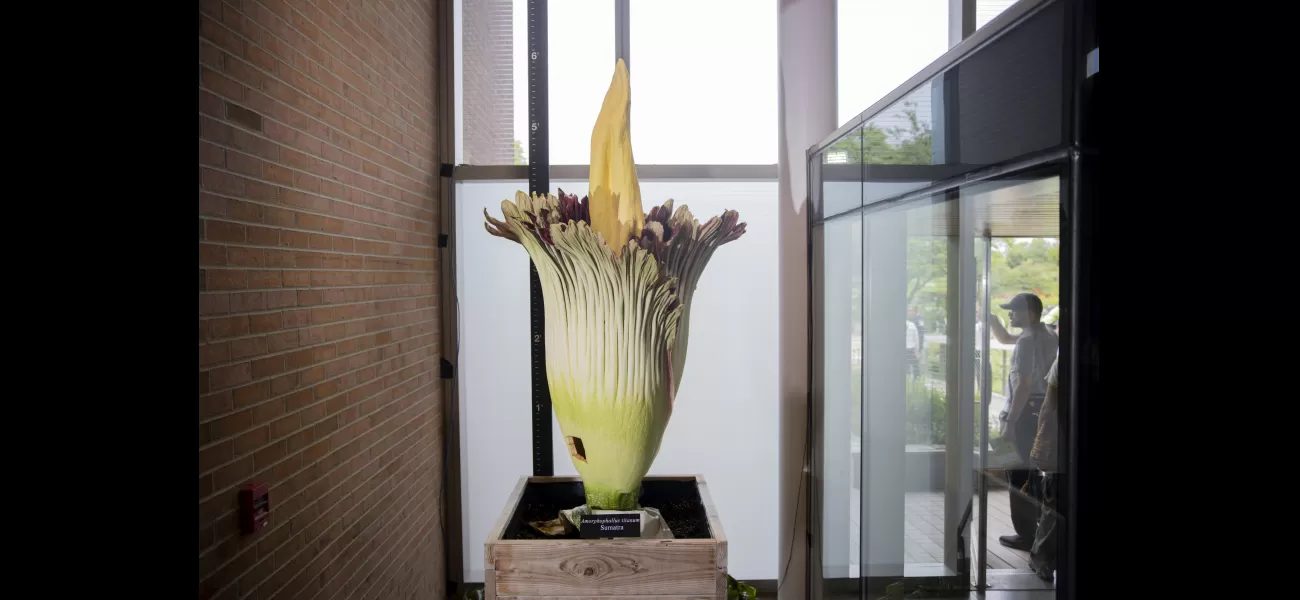Two smelly corpse flowers bloom at the Chicago Botanic Garden.
The "corpse flower" known as the titan arum is currently blooming at the Chicago Botanic Garden in Glencoe.
June 8th 2024.

Tony Holland stood in awe as he gazed up at the massive flower towering over him at over 6 feet tall. Its pungent scent filled the air, reminiscent of decaying flesh. It was a dream come true for Holland, who couldn't believe he was actually witnessing this rare titan arum in full bloom.
At 36 years old, Holland couldn't contain his excitement. "Just being able to check this off my bucket list is huge," he exclaimed. "It's truly amazing."
Known as the "corpse flower" due to its putrid odor, this titan arum was on display at the Chicago Botanic Garden in Glencoe. Its flowering structure, the largest unbranched inflorescence in the world, is a sight to behold - and smell.
The plant emits its foul stench to attract its natural pollinators, carrion beetles and flesh flies. Among the crowd of curious visitors, 5-year-old Sally Uttech wrinkled her nose and muttered, "It smells bad."
Since 2003, the Botanic Garden has been home to these endangered species, nurturing 18 of them. Native to the rugged rainforests of Sumatra, an Indonesian island along the equator, most of these plants are now cultivated in gardens around the world.
The titan arum takes over a decade to develop before its first bloom, and even then, its cycle is unpredictable. Scientists often struggle to determine whether new growth is a leaf or a flower bud, which typically emerges every three to four years. For Plant Production Manager Tim Pollak, the unpredictability only adds to the excitement.
"We're proud of our success in getting them to bloom," Pollak shared as he tended to the plants year-round. "And knowing that it's the largest inflorescence in the world is simply breathtaking."
The current titan arum in bloom, named Sumatra, is on its third bloom since 2017. Another flower, Spike, is expected to bloom for the fourth time in the coming week.
On June 8, 2024, people gathered around these famous corpse flowers at the Chicago Botanic Garden in Glencoe. When a bud emerges, the plant grows 5 to 6 inches per day for about two weeks, with a spiky spadix rising above the spathe. Finally, the growth slows, the spathe unfurls, and the plant releases its foul odor over a period of several hours. Its color changes to a maroon, meat-like hue to attract pollinators.
In years when the flower is not in bloom, it instead produces a massive leaf that can stretch up to 15 feet in the air.
The growth of more corpse flowers is a collaborative effort with other gardens around the country. The Botanic Garden freezes and ships pollen so that the titan arums can reproduce with other members of the species.
"We're like a pollen bank for other facilities," Pollak explained. "The botanic garden community is very cooperative, as we all need pollen and are willing to share it."
Dozens of people gathered around the two titan arums, housed in wooden planters, on a recent morning. Many snapped photos beside them, while others dared to take a whiff as they approached.
Holland and his family drove three hours from the Quad Cities just to see these plants in person. He first learned about the elusive titan arum 15 years ago and had been closely monitoring the ones at the Botanic Garden online.
"I told my boss, 'When I get the alert, I'm gone. I'm disappearing for 24 hours or so,'" Holland laughed. "My wife texted me yesterday that Sumatra had opened, and I immediately said, 'We're going first thing in the morning!'"
Travis VanZuiden, 37, and Veronica Spriggs, 38, also made the three-hour drive from Iowa to witness the corpse flower in bloom. It certainly lived up to their expectations.
"They're huge, rare, and just so unusual," VanZuiden remarked as he stared at the flowers. "It doesn't even look real."
The couple admitted that the smell wasn't as bad as they had anticipated. The sheer size of the flowers seemed to distract from the odor.
"He's been talking about this for years, and I was like, 'Okay,'" Spriggs said. "But now that I'm here, I totally get it. It's really cool."
At 36 years old, Holland couldn't contain his excitement. "Just being able to check this off my bucket list is huge," he exclaimed. "It's truly amazing."
Known as the "corpse flower" due to its putrid odor, this titan arum was on display at the Chicago Botanic Garden in Glencoe. Its flowering structure, the largest unbranched inflorescence in the world, is a sight to behold - and smell.
The plant emits its foul stench to attract its natural pollinators, carrion beetles and flesh flies. Among the crowd of curious visitors, 5-year-old Sally Uttech wrinkled her nose and muttered, "It smells bad."
Since 2003, the Botanic Garden has been home to these endangered species, nurturing 18 of them. Native to the rugged rainforests of Sumatra, an Indonesian island along the equator, most of these plants are now cultivated in gardens around the world.
The titan arum takes over a decade to develop before its first bloom, and even then, its cycle is unpredictable. Scientists often struggle to determine whether new growth is a leaf or a flower bud, which typically emerges every three to four years. For Plant Production Manager Tim Pollak, the unpredictability only adds to the excitement.
"We're proud of our success in getting them to bloom," Pollak shared as he tended to the plants year-round. "And knowing that it's the largest inflorescence in the world is simply breathtaking."
The current titan arum in bloom, named Sumatra, is on its third bloom since 2017. Another flower, Spike, is expected to bloom for the fourth time in the coming week.
On June 8, 2024, people gathered around these famous corpse flowers at the Chicago Botanic Garden in Glencoe. When a bud emerges, the plant grows 5 to 6 inches per day for about two weeks, with a spiky spadix rising above the spathe. Finally, the growth slows, the spathe unfurls, and the plant releases its foul odor over a period of several hours. Its color changes to a maroon, meat-like hue to attract pollinators.
In years when the flower is not in bloom, it instead produces a massive leaf that can stretch up to 15 feet in the air.
The growth of more corpse flowers is a collaborative effort with other gardens around the country. The Botanic Garden freezes and ships pollen so that the titan arums can reproduce with other members of the species.
"We're like a pollen bank for other facilities," Pollak explained. "The botanic garden community is very cooperative, as we all need pollen and are willing to share it."
Dozens of people gathered around the two titan arums, housed in wooden planters, on a recent morning. Many snapped photos beside them, while others dared to take a whiff as they approached.
Holland and his family drove three hours from the Quad Cities just to see these plants in person. He first learned about the elusive titan arum 15 years ago and had been closely monitoring the ones at the Botanic Garden online.
"I told my boss, 'When I get the alert, I'm gone. I'm disappearing for 24 hours or so,'" Holland laughed. "My wife texted me yesterday that Sumatra had opened, and I immediately said, 'We're going first thing in the morning!'"
Travis VanZuiden, 37, and Veronica Spriggs, 38, also made the three-hour drive from Iowa to witness the corpse flower in bloom. It certainly lived up to their expectations.
"They're huge, rare, and just so unusual," VanZuiden remarked as he stared at the flowers. "It doesn't even look real."
The couple admitted that the smell wasn't as bad as they had anticipated. The sheer size of the flowers seemed to distract from the odor.
"He's been talking about this for years, and I was like, 'Okay,'" Spriggs said. "But now that I'm here, I totally get it. It's really cool."
[This article has been trending online recently and has been generated with AI. Your feed is customized.]
[Generative AI is experimental.]
0
0
Submit Comment





